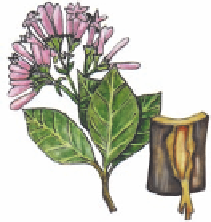Environmental Engineering Reference
In-Depth Information
Rosy periwinkle
Cathranthus roseus,
Madagascar
Hodgkin's disease,
lymphocytic leukemia
Pacific yew
Taxus brevifolia,
Pacific Northwest
Ovarian cancer
Rauvolfia
Rauvolfia sepentina,
Southeast Asia
Tranquilizer, high
blood pressure
medication
Neem tree
Azadirachta indica,
India
Treatment of many
diseases, insecticide,
spermicide
Foxglove
Digitalis purpurea,
Europe
Digitalis for heart failure
Cinchona
Cinchona ledogeriana,
South America
Quinine for malaria treatment
Figure 9-6
Natural capital:
nature's pharmacy.
Parts of these and a number of other plants and animals (many
of them found in tropical forests) are used to treat a variety of human ailments and diseases. Nine of the ten
leading prescription drugs originally came from wild organisms. Approximately 2,100 of the 3,000 plants identi-
fied by the National Cancer Institute as sources of cancer-fighting chemicals come from tropical forests. Despite
their economic and health potential, fewer than 1% of the estimated 125,000 flowering plant species in tropical
forests (and a mere 1,100 of the world's 260,000 known plant species) have been examined for their medicinal
properties. Once the active ingredients in the plants have been identified, they can usually be produced syn-
thetically. Many of these tropical plant species are likely to become extinct before we can study them.
spend more than three times as many hours watching
wildlife—doing nature photography and bird watch-
ing, for example—as they spend watching movies or
professional sporting events.
Conservation biologist Michael Soulé estimates
that one male lion living to age 7 generates $515,000 in
eco-tourist dollars in Kenya but only $1,000 if it is killed
for its skin. Similarly, over a lifetime of 60 years, a
Kenyan elephant is worth about $1 million in eco-
tourist revenue—many times more than its tusks are
worth when they are sold illegally for their ivory.
Eco-tourism should not cause ecological damage
but some of it does. The website for this chapter lists
some guidelines for evaluating eco-tours.
Some people distinguish between the survival
rights of plants and those of animals, mostly for practi-
cal reasons. Poet Alan Watts once said he was a vege-
tarian “because cows scream louder than carrots.”
Other people distinguish among various types of
species. For example, they might think little about get-
ting rid of the world's mosquitoes, cockroaches, rats,
or disease-causing bacteria.
Some conservation biologists caution us not to
focus primarily on protecting relatively large organ-
isms—the plants and animals we can see and are
familiar with. They remind us that the true foundation
of the earth's ecosystems and ecological processes are
invisible bacteria and the algae, fungi, and other
microorganisms
that decompose the bodies of larger
organisms and recycle the nutrients needed by all life.
Ethics: The Intrinsic Value
of Wild Species
Some believe that each wild species has an inherent
right to exist.
Some people believe that each wild species has
intrin-
sic
or
existence
value based on its inherent right to exist
and play its ecological roles, regardless of its useful-
ness to humans. According to this view, we have an
ethical responsibility to protect species from becoming
prematurely extinct as a result of human activities, and
to prevent the degradation of the world's ecosystems
and its overall biodiversity.
9-3 CAUSES OF PREMATURE
EXTINCTION OF WILD SPECIES
Science: Habitat Loss and Degradation—
Remember HIPPO
The greatest threat to a species is the loss and
degradation of the place where it lives.
Figure 9-7 (p. 190) shows the basic and secondary
causes of the endangerment and premature extinction







